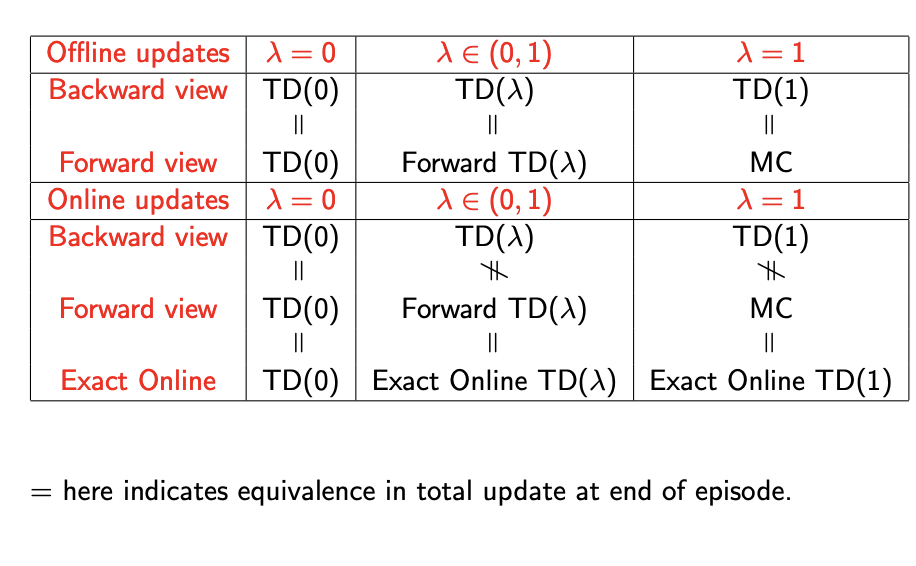AI Model-Free Prediction
Introduction
Estimate the value function of an unknown MDP
Monte-Carlo Reinforcement Learning
-
MC methods learn directly from episodes of experience
- MC is model-free
- No knowledge of MDP transitions/rewards
-
MC learns from complete episodes: no bootstrapping
- MC uses the simplest possible idea
- value = mean return
- Caveat
- Can only apply MC to episodic MDPs
- All episodes must terminate
Monte-Carlo Policy Evaluation
-
Goal: learn $v_\pi$ from episodes of experience under policy $\pi$
-
Return is the total discounted reward:
-
Value function is the expected return: \(v_\pi(s) = R_{\pi} [G_t | S_t = s]\)
-
Monte-Carlo policy evaluation uses empirical mean return instead of expected return
First-Visit Monte-Carlo Policy Evaluation
- To evaluate state s
-
The first time-step t that state s is visited in an episode
-
increment counter $N(s) += 1$
-
increment total return $S(s) = S(s) + G_t$
-
value is estimated by mean return $V(s) = \frac{S(s)}{N(s)}
-
by law of large numbers, $V(s) = v_pi(s) as N(s) approaches infinity.
-
Every-visit Monte-Carlo Policy Evaluation
- To evaluate state s
-
Every time-step t that state s is visited in an episode,
-
increment counter $ N(s) += 1$
-
increment total return $S(s) = S(s) + G_t$
-
value is estimated by mean return $V(s) = \frac{S(s)}{N(s)}
-
by law of large numbers, $V(s) = v_pi(s) as N(s) approaches infinity.
-
Incremental Mean
The mean $\mu_1, \mu_2, \dots$ of a sequence can be computed incrementally
\[\mu_k = \frac{\sum_{j=1}^k x_j}{k}\] \[\mu_k = \mu_{k-1} + \frac{x_k -\mu_{k-1}}{k}\]Incremental Monte-Carlo Updates
- Update V(s) incrementally after episodes $S_1,A_1,$
- For each state $S_t$ with return $G_t$ $$ N(S_t) = N(S_t) + 1
V(S_t) = V(S_t) + \frac{G_t - V(S_t)}{N(S_t)} $$
-
In non-stationary problems, it can be useful to track a running mean, i,e, forget old episodes. $$
V(S_t) = V(S_t) + \alpha (G_t - V(S_t)) $$
Temporal-Difference Learning
-
TD methods learn directly from episodes of experience
-
TD is model-free: no knowledge of MDP transitions/rewards
-
TD learns from incomplete episodes, by bootstrapping
-
TD updates a guess towards a guess
MC and TD
-
Goal: learn $v_\pi$ online from experience under policy $\pi$
-
Incremental every-visit Monte-Carlo
- Update value $V(S_t)$ toward actual return $G_t$
-
Simplest temporal-difference learning algorithm: TD(0)
- Update value $V(S_t)$ toward estimated return $$
V(S_t) = V(S_t) + \alpha (R_{t+1} + \gamma V(S_{t+1}) - V(S_t))$ $$
-
$R_{t+1} + \gamma V(S_{t+1})$ is called the TD target
-
$\delta_t = R_{t+1} + \gamma V(S_{t+1}) - V(S_t)$ is called the TD error
Pros and Cons of MC vs TD
- TD can learn before knowing the final outcome
- TD can learn online after every step
- MC must wait until end of episode before return is known
- TD can learn online after every step
- TD can learn without the final outcome
- TD can learn from incomplete sequences
- MC can only learn from complete sequences
- TD works in non-terminating environments
- MC only works for episodic/terminating environments
- TD can learn from incomplete sequences
- MC has high variance, zero bias
-
Good convergence properties even with function approximation
-
Not very sensitive to initial value
-
Very simple to understand and use
-
- TD has low variance, some bias
-
Usually more efficient than MC
-
$TD(0)$ converges to $v_pi(s)$, but not always with function approximation
-
More sensitive to initial value
-
- TD expoits Markov property
- Usually more efficient in Markov environments
- MC does not exploit Markov property
- Usually more effective in non-Markov environments
Bootstrapping and Sampling
- Bootstrapping: update involves an estimate
-
MC does not bootstrap
-
DP bootstraps
-
TD bootstraps
-
- Sampling: update samples an expectation
- MC samples
- DP does not sample
- TD samples
TD($\lambda$)
n-step Prediction
-
Let TD target look n steps into the future
-
Define the n-step return
-
n-step temporal-difference learning
Large Random Walk Example
Averaging n-step Returns
-
We can average n-step returns over different n
-
e.g. average the 2-step and 4-step returns
-
Combines information from two different time-steps
-
Can we efficiently combine information from all time-steps?
$\lambda$-return
$TD(\lambda)$ Weighting Function
Forward-view $TD(\lambda)$
-
Update value function towards the $TD(\lambda)$
-
Forward-view looks into the future to compute $G_t^{\lambda}$
-
Like MC, can only be computed from complete episodes
Forward-view $TD(\lambda)$ on Large Random Walk
Backward View $TD(\lambda)$
-
Forward view provides theory
-
Backward view provides mechanism
-
Update online, every step, from incomplete sequences
Eligibility Traces
-
Credit assignment problem: did bell or light cause shock?
-
Frequency heuristic: assign credit to most frequent states
-
Recency heuristic: assign credit to most recent states
-
Eligibility traces combine both heuristics
Backward View $TD(\lambda)$
-
Keep an eligibility trace for every state s
-
Update value V(s) for every state s
-
In proportion to TD-error and eligibility trace
$TD(\lambda)$ and $TD(0)$
- when $\lambda$ = 0 , current state is updated
$TD(\lambda)$ and MC
-
When $\lambda$ = 0, credit is deferred until end of episode
-
Consider episodic environments with offline updates
-
Over the course of an episode, total update for $\lambda$ = 0 is the same as total update for MC
$TD(1)$ and MC
- Consider an episode where s is visited once at time-step k
Telescoping in $TD(\lambda)$
$TD(\lambda)$ and $TD(1)$
Telescoping in $TD(\lambda)$
Forwards and Backwards in $TD(\lambda)$
- $TD(\lambda)$ eligibility trace discounts time since visit
Offline Equivalence of Forward and Backward TD
-
Offline updates are accumulated within episode
- applied in batch at the end of the episode
Online Equivalence of Forward and Backward TD
-
$TD(\lambda)$ updates are applied online at each step within episode
-
Forward and backward-view $TD(\lambda)$ are slightly different
-
Exact online $TD(\lambda)$ achieves perfect equivalence
-
By using a slightly different form of eligibility trace
Final Summary
